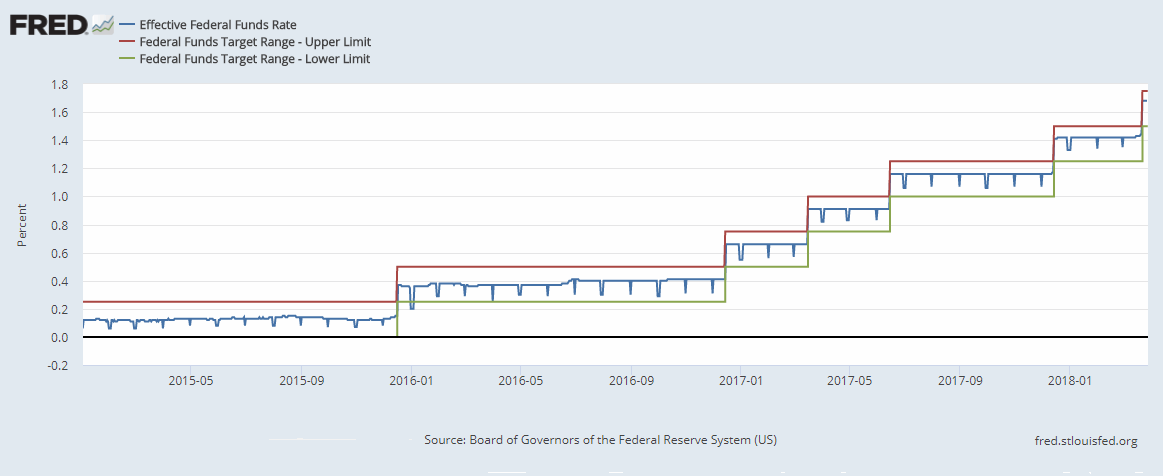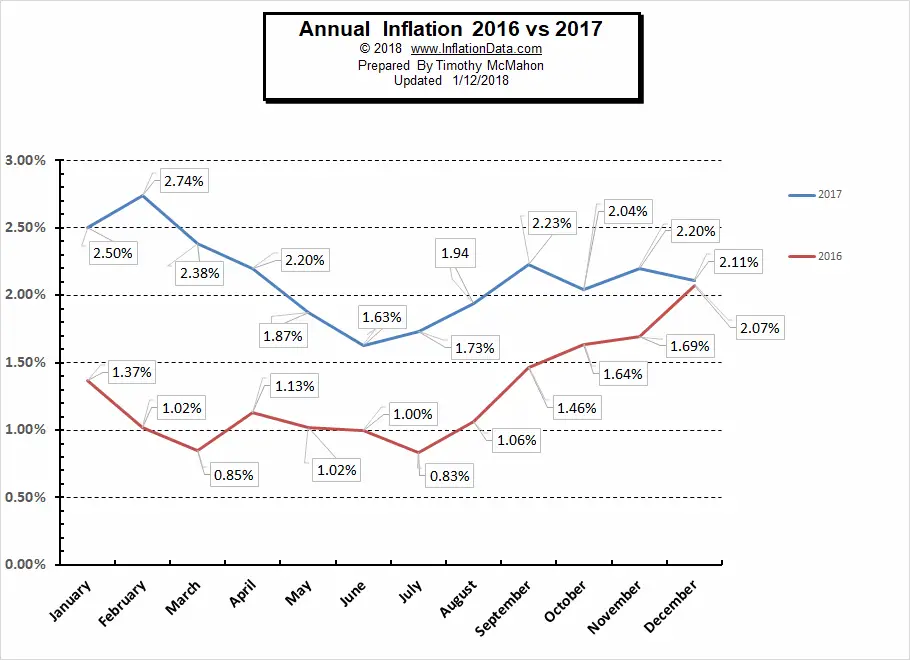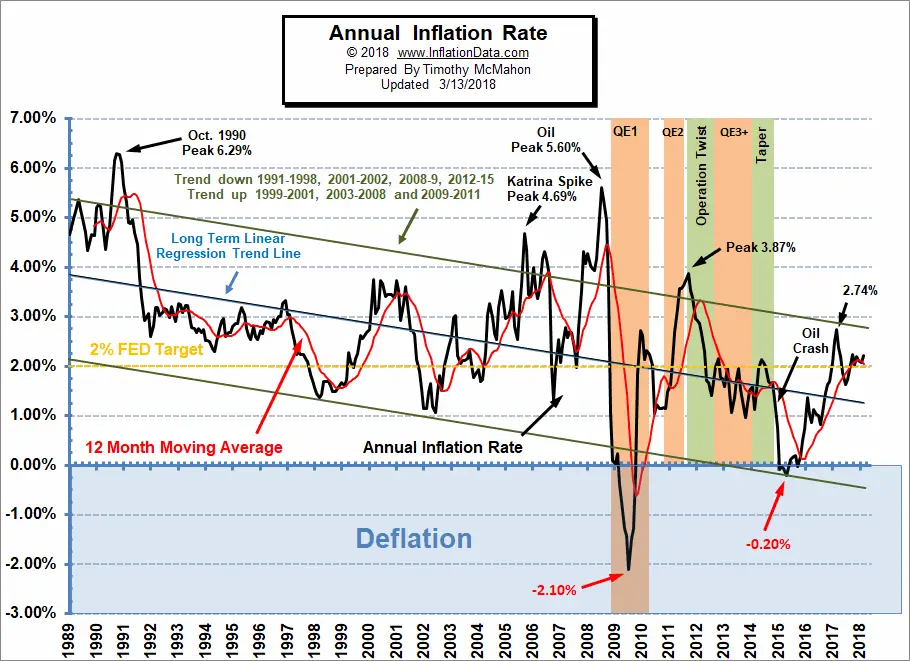In common usage, inflation refers to steadily rising prices of goods and services over time, while “deflation” relates to falling prices. Inflation is both a boon and a bane to the economy and the rate of inflation is affected by a variety of factors including FED monetary policy, interest rates, supply vs. demand, and the Velocity of money.
However, strictly speaking, rising prices are “price inflation” which is generally caused by “monetary inflation” i.e. the expansion of the money supply, among other things. See What is Inflation? for more info.
Many Keynesian Economists believe that Inflation is a prerequisite for economic growth and prosperity and Keynesians believe Monetary policy is one of the most powerful mechanisms used to control inflation.
Scarcity
The economic principle of scarcity occurs when too much money (which can result from an over exuberant expansion of the money supply) is chasing too few goods (which can result from supply disruptions, etc) . To balance things out, prices rise, which tends to temper demand. This gives rise to inflationary pressures and encourages more production. The profit motive is always present in an inflationary-style economy, but profit motives alone are not responsible for inflationary pressures. Consider the case of the Eurozone, and Japan which were agonizing through deflation – price contractions due to sub-optimal economic performance. See What is Demand Pull Inflation? for more info.
What’s particularly noticeable to most households about the impact of inflation is its effect on personal disposable incomes (PDI), or simply the purchasing power of your money. As prices rise relative to your wages or salary, so your PDI declines i.e. whenever you go shopping you notice that you can buy less with every £1 or $1. To keep pace with inflation, employees pressure their employers to raise wages and salaries, which in turn feeds into the inflation cycle. However, if demand is not sufficient for the company’s products to support both increased costs of goods and increased personnel costs the company will generally be forced to lay-off personnel.
Rising Interest Rates
In March 2018, the Federal Reserve decided to hike its federal funds rate target range by a quarter point to 1.5%-1.75%. When central banks such as the Federal Reserve Bank (FED), the Bank of England, the European Central Bank, the Bank of Japan, or the Bank of Canada, are trying to curb runaway inflation, they raise interest rates. Raising interest rates is one way the FED pursues quantitative tightening but are really just another form of higher costs. According to Investopedia, “When interest rates increase, there are real world effects on the ways that consumers and businesses can access credit to make necessary purchases and plan their finances.” Read more: The Impact of a Fed Interest Rate Hike
A hike in the Feds rate will cause a rise in the prime rate, i.e. the credit rate that banks extend to their best customers. Banks then base other rates such as the rates offered for credit cards, mortgages, and other loans on the prime rate. If mortgage rates rise, fewer people will qualify for home loans and that puts downward pressure on demand for new homes.
The Federal Funds Rate (FFR)
On Wednesday, 21 March 2018, the Fed raised the federal funds rate (FFR) by 25 basis points. Now, the interest rate is hovering in the region of 1.50% – 1.75% – the highest level since interest rates plunged after the global financial crisis. Rate hikes are common when the Fed is trying to tighten up on runaway inflation, or to temper a red-hot economy. Presently, the US economy is showing moderate growth, with GDP recently revised higher with a 2.9% annualized growth for Q4 2017. Analysts were expecting GDP growth of 2.7%.
Quantitative Tightening
Quantitative Tightening is the opposite of quantitative easing which took place after the global financial crisis of 2008-2009. At that time, there was a contraction in overall economic activity and the monetary authorities wanted to encourage spending. Beginning in 1977 Congress imposed a “Dual Mandate” on the Fed requiring both price stability and full employment.
Many economists believe that inflation problems begin when central banks “print” too much money. However, that’s somewhat simplistic. These days the “money supply” is a complex creation based on a variety of components. In addition to cash, these components include Checking and Savings accounts, Travelers checks, Money Market Accounts, Time Deposits, etc. But even though these are the official definition of “Money Supply” people consider their stock portfolios and even the value of their house as part of their “wealth” so in 2008 when the stock market crashed and housing prices fell people felt “poorer” and thus they spent less and saved more. This resulted in a massive contraction of the “perceived money supply” and so even though the FED instituted “Quantitative Easing” on a massive scale, prices still declined.
What is the velocity of money?
Simply defined the velocity of money is the turnover in the money supply. A shop owner can measure how fast his inventory is selling by calculating “inventory turnover.” To do that he simply calculates Total Sales ÷ Average Inventory for the period in question. But if you expand the idea of turnover to the entire country you get the “Velocity of Money”.
Strictly speaking all the velocity of money tells us is how long people hold onto their money. But from that we can infer their motives and perceptions of the economy in general… for instance generally in times of high inflation people want to spend their money as quickly as possible before it loses too much purchasing power.
See: “Velocity of Money”. for more information.
Measuring Inflation
Two important measures are used to evaluate inflation – the CPI (Consumer Price Index) which measures the typical price of a basket of goods, based on reports issued by the BLS (Bureau of Labor Statistics) the CPI is then used to calculate the annual inflation rate. The Fed often emphasizes the price inflation measure for personal consumption expenditures (PCE), produced by the Department of Commerce, largely because the PCE index covers a wide range of household spending. However, the Fed closely tracks other inflation measures as well, including the consumer price indexes and producer price indexes issued by the Department of Labor. See How does the Federal Reserve evaluate changes in the rate of inflation?
The Fed has targeted an inflation rate of 2%, and recently it is on track to maintaining that. The current inflation rate in the US is 2.21% and has been holding relatively steady since September 2017 bouncing between 2.00% and 2.23%.
| August 2017 | 1.94% |
| September 2017 | 2.23% |
| October 2017 | 2.04% |
| November 2017 | 2.20% |
| December 2017 | 2.11% |
| January 2018 | 2.07% |
| February 2018 | 2.21% |
Earlier periods the FED did not fare as well at maintaining its target as we can see from the chart below.
Inflationary Pressures on Commodities
Inflation, interest rates, Foreign Exchange Rates and money supply all have a definitive impact on demand and supply of commodities. When the prices increase, the basic economic principle kicks in: Higher Price = Lower Demand. However, not all commodities are created equal and so we must also consider the concept of “elasticity of demand”. Elasticity comes into play as prices rise or fall. If a price rises on a commodity that you merely “want” you might comparison shop more and even be willing to substitute an item of lesser quality to keep the price down (this would be a relatively “elastic” commodity). A more elastic commodity you might be willing to forego altogether. However, something you need to survive like food or energy is relatively “inelastic” meaning that you will pay whatever you have to, in order to get it even if that means foregoing other items that you merely want.
Commodities Futures and Options markets help to stabilize prices by allowing risk transference from producers to speculators. They also create liquidity for those markets. Trading activity reflects a variety of forces in the commodities markets from inflationary pressures to weather and world events. Experts routinely offer trading advice when it comes to demystifying commodities trading. According to a leading commodities trader, Sergio K, ‘There are several ways to trade commodities, including exchange traded funds, contracts for difference, stocks, options, futures, over-the-counter, and outright ownership. Multiple factors impact demand for commodities, notably scarcity, geopolitical considerations, economic policy, climactic factors, technological innovation and so forth. Inflation is always a hot topic when it comes to commodity pricing, and it should feature prominently in your decision-making process.’
Referenced articles:
- What is Inflation?
- What is Deflation?
- Keynesian vs. Austrian Economics
- What is Demand Pull Inflation?
- The Impact of a Fed Interest Rate Hike
- What is Quantitative Easing?
- What is Velocity of Money?
- How does the Federal Reserve evaluate changes in the rate of inflation?
- Historical Consumer Price Index
- Current Inflation Rate
- What is “FinTech”?





Leave a Reply